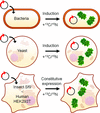issue contents
March 2017 issue

editorial
PHYSICS | FELS
Serial crystallography was developed for the use at free-electron lasers but the approach has recently also been adapted to synchrotron sources. Here we discuss how the synergy between the two X-ray sources will facilitate a wide application of the technique in microcrystallography, room-temperature structure determination and time-resolved studies.
scientific commentaries
BIOLOGY | MEDICINE
High-resolution NMR provides increasing possibilities to probe biomolecular structure in the native state. In this issue, Luchinat and Banci [IUCrJ (2017), 4, 108–118] discuss progress on using in-cell NMR in prokaryotic and eukaryotic cell preparations.
PHYSICS | FELS
A breakthrough in the high-pressure structures of Ba based on a full exploitation of aperiodic symmetry is discussed in the general context of the `complex structures of simple metals'.
PHYSICS | FELS
Metal–organic frameworks (MOFs) are potentially useful materials for hydrogen and methane storage. However, the weak interactions between the MOF host and gas guest molecules have limited their storage capacities at elevated temperatures. In this issue, Alkordi et al. [IUCrJ (2017), 4, 131–135] illustrate an example of a porous MOF with a suitable pore size and unique pore surface for enhanced interaction with hydrogen molecules, providing the promise of further increasing the gas binding affinity through collaborative interactions.
topical reviews
BIOLOGY | MEDICINE
In-cell NMR has emerged in the past decade as a unique approach to obtain structural and functional information on biological macromolecules within living cells at atomic resolution. In this review, the major advances of in-cell NMR are discussed, with a special focus on recent developments and applications in eukaryotic and mammalian cells.
BIOLOGY | MEDICINE
This review discusses advances in mass spectrometry-based strategies to investigate receptor tyrosine kinase signalling networks and activation dynamics.
research letters
CHEMISTRY | CRYSTENG
Download citation


Download citation


Controlling the MOF pore geometry, size and functionality is of prime importance for the effective and selective gas adsorption. Gas adsorption studies on ultra-microporous MOFs were conducted to gain insight on the pore geometry–sorption energetics relationship.
CCDC reference: 1528379
research papers
MATERIALS | COMPUTATION
In this study, the X-ray constrained wavefunction approach is carefully investigated in order to assess its ability to capture the effect of electron correlation on electron density. Electron distributions obtained from highly correlated molecular wavefunctions are the benchmarks and their Fourier transforms are used to simulate X-ray intensities for the constrained wavefunction calculations.
BIOLOGY | MEDICINE
A new experimental setup, developed for imaging human chromosomes under cryogenic conditions using beamline I13 at Diamond Light Source, is described.
PHYSICS | FELS
Download citation


Download citation


Using single-crystal synchrotron radiation X-ray experiments, the host–guest structure of the Ba IVb high-pressure phase has been solved for the first time. The proposed systematic analysis of possible host–guest structure models shows that the structure belongs to the incommensurately modulated type. This model reveals an atomic density wave and its pressure-dependent evolution between 16.5 and 19.6 GPa.
B-IncStrDB reference: 13062EqEcIW
CHEMISTRY | CRYSTENG
Intermolecular crystal contacts formed by different oxygen atom types are investigated.
MATERIALS | COMPUTATION
The performance of a fully automatically generated tailor-made force field in the field of NMR crystallography is evaluated and compared with existing benchmarks. The advantages and limitations of NMR crystallography with motional averaging are revealed in this study.
BIOLOGY | MEDICINE
The crystal structure of autolysin E, an N-acetylglucosaminidase from S. aureus, reveals the structural basis of the selection mechanism of muramidases and glucosaminidases for docking the two chemically equivalent, yet distinct in sequence, β-glycosidic bonds in NAG-NAM polymers.



 journal menu
journal menu




 access
access
























